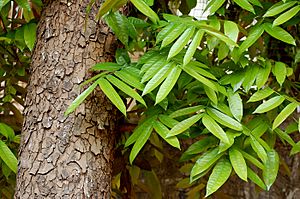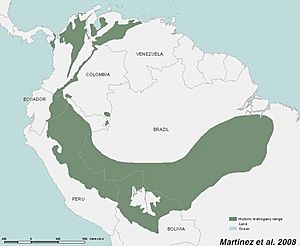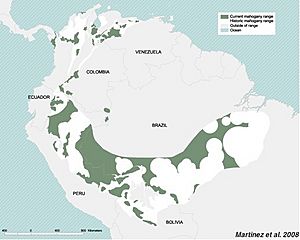Big leaf mahogany facts for kids
Quick facts for kids Big leaf mahogany |
|
|---|---|
 |
|
| Conservation status | |
| Scientific classification | |
| Genus: |
Swietenia
|
| Species: |
macrophylla
|
 |
|
| Historic range of big-leaf mahogany in South America | |
 |
|
| Current range of big-leaf mahogany in South America | |
| Synonyms | |
|
|
Swietenia macrophylla, often called mahogany or big-leaf mahogany, is a type of plant in the Meliaceae family. It's one of only three kinds of trees that produce real mahogany wood. The other two are Swietenia mahagoni and Swietenia humilis.
This tree originally comes from South America, Mexico, and Central America. However, it has also started growing naturally in places like the Philippines, Singapore, Malaysia, and Hawaii. People also plant it in special tree farms and use it to create wind-breaks.
Contents
About Mahogany Trees
Wood
Mahogany wood is very strong and beautiful. It's often used to make furniture, musical instruments, and even parts of ships. You might also find it in doors, coffins, and decorative items.
Leaves
Mahogany trees are easy to spot because of their very large leaves. These leaves can grow up to 45 centimeters (about 18 inches) long! Each leaf has many smaller leaflets connected to a main stem.
Fruits
The fruits of the mahogany tree are quite unique. They are often called "sky fruits" because they grow upwards towards the sky. These fruits can be as long as 40 centimeters (about 16 inches). They look like light grey to brown capsules. Inside each fruit capsule, you can find around 71 winged seeds.
Seeds
Mahogany seeds are also quite large. They can measure between 7 to 12 centimeters (about 3 to 5 inches) long.
Mahogany Wood for Sale
Mahogany wood that comes from tree farms in Asia is not restricted in trade. This means it can be bought and sold freely around the world. Today, most of the real mahogany wood sold internationally comes from these Asian tree farms.
Many Asian countries grow Swietenia macrophylla. The main suppliers are India and Fiji. Other countries that grow it include Indonesia, Malaysia, Bangladesh, Philippines, and Singapore. The tree is also planted in Laos.
Possible Health Uses
Scientists have studied mahogany seeds to see if they have any health benefits. Some people claim that mahogany seeds can help improve blood circulation and skin condition.
However, it's important to be careful. There have been reports of people having liver problems after eating mahogany seeds. This happened whether the seeds were eaten raw or ground into a powder and put into capsules. In some cases, kidney problems were also reported. Luckily, most people got better after they stopped eating the seeds.
Scientists are still trying to understand why these problems happen. It might be because people took too much, or perhaps the seeds were not clean. Studies suggest that eating mahogany seeds is safe if the dose is less than 325 milligrams per kilogram of body weight. In traditional Malaysian medicine, people usually take only one seed per day.
Common Names
This tree is known by many different names around the world.
- English - big leaf mahogany, large-leaved mahogany, Brazilian mahogany
- French - acajou à grandes feuilles, acajou du Honduras
- Spanish - caoba, mara, mogno
- Malayalam - mahagony
- Tamil - Thenkani (தேன்கனி)
- Telugu - mahagani, peddakulamaghani
- Sinhala - mahogani (මහෝගනි)
Images for kids
See also
 In Spanish: Swietenia macrophylla para niños
In Spanish: Swietenia macrophylla para niños












